- CONTENTS:
- Letter from the EditorTable of Contents"Smart"Change in Strategy: IBM’s Response to Challenging Times IBM and the Future: Building a Smarter PlanetOliver Winery and the Recipe for Values-Based Leadership: People, Product and PlaceHolistic Leadership: A Model for Leader-Member Engagement and Development A Tale of Two Cultures: Why Culture Trumps Core Values in Building Ethical OrganizationsLeadership: The Tabletop Concept The Leader as Moral Agent: Praise, Blame, and the Artificial Person
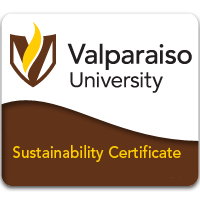
- OLIVER WINERY AND THE RECIPE FOR VALUES-BASED LEADERSHIP: PEOPLE, PRODUCT AND PLACE


Allyson Baughman, M.B.A.
Valparaiso University
AlexandraSchroeder, M.A.
Indiana University

Dean Schroeder, PH.D.
University of MinnesotaIntroduction: Doing Well by Doing Good
Nearly 275 years ago, Benjamin Franklin urged his countrymen to mold success upon the forge of virtuous conduct. "Do well," he instructed, "by doing good." Today, in the ubiquitous presence of what Tozi (2010) derides as freewheeling "short-termism," a chorus of business leaders, stakeholders and critics are echoing Franklin's call for sustainable, ethical business practices. This proposed "values-based revolution" (Brauer, 2009) advocates leading with authenticity, integrity and steadfastness in promoting principles within the workplace. Such an approach encourages employees to be trusting, empowered and motivated while attracting loyal customers who are engaged with the company and the values it brings to the market (Albion, 2008; Kouzes and Posner, 2007, pp. 221-272; Millick, 2009).
While empirical and anecdotal evidence (Brauer, 2009; Dean, 2008) and simple common sense indicate that people prefer to work for, patron and otherwise engage with values-based businesses, how to create and manage such organizations sustainably and profitably is less clear. In this paper, we share the story of a values-based company that has achieved extraordinary, resilient success; an achievement that is rooted in its leaders' ability to consistently integrate their personal values into daily operations. We examine the company's systems and practices in terms of its people-centered focus, and extract lessons that all business leaders will find helpful in pursuing their own values-based endeavors.
Oliver Winery
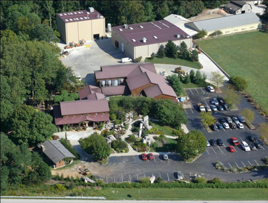
Oliver Winery is located close to Highway 37 in southern Indiana, seven miles north of Bloomington, the home of Indiana University's main campus. The state's oldest and largest winery, the company began public operations in 1972, though its roots may be traced to the previous decade, when founder Professor William Oliver began making small batches of wine in his basement. Oliver's first successful commercial product was known as Camelot Mead, a wine made from the honey of local apiarists that quickly attracted a devoted local following.
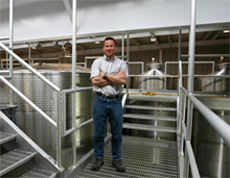
Bill OliverBill Oliver, Professor Oliver's son, assumed operating control of the winery in 1983. Together with his wife Kathleen, Bill has transformed the company from little more than a hobbyist's operation into a state-of-the-art, nationally renowned winery that produces over 820,000 gallons (or 354,000 cases) of wine annually. The producer of the top two selling wines in both Indiana and Kentucky, the winery often captures other slots in those states' top five rankings each year. Oliver Winery's success has been featured in Bon Apetite (1995), the "Tastings" section of the Wall Street Journal (2001), Indianapolis Monthly magazine (2007), and MidwestLiving.com (2009). Additionally, it was the only non-Californian winery to be included in Wine Business Monthly magazine's "The Hottest Small Brands of 2004" (Oliver was ranked #4 out of 10).
Commercial success has accompanied critical acclaim. The winery's sales have increased by double digits annually over the last quarter century, and net profits have ranged between 13 and 18 percent for the past five years. National demand for the company's product is growing: Oliver wines can now be purchased in fifteen states, and sales in Kentucky, Ohio, Michigan, and Illinois increased by 35 percent between 2008 and 2009. For the rest of the increasingly crowded U.S. wine market, average growth rates have dropped from 9 to 4 percent in the past two years and net profits have averaged less than 10 percent over the past eight years (McMillan, 2010).
What is even more impressive is that Oliver's success has been achieved while operating from within a state that historically has not been kind to hopeful wine makers - either legislatively or geographically. While political obstacles have in large part been overcome, the state's climate of cold winters and hot, humid summers still prevents all but the most ingenuous and attentive growers from consistently harvesting superior yields. In light of these challenges and in comparison to broader industry performance, how have the Olivers led their values-based business to such success?
Reinforcing Values by Managing the "3 Ps"
Bill and Kathleen Oliver believe that an extraordinary business is composed of thousands of right choices by both leadership and staff about how to ethically engage its people, product, and place - the "3 Ps." Kathleen Oliver explains the manifestation of this company value of "alignment" throughout the winery's operations:
"People, product, and place: Each one is integral to our success - if one component fails, then we greatly reduce our positive impact on customers. When the customer gets to our facility, the grounds should look spectacular, setting the stage for what's to come inside the tasting room. Once inside, our service is what sets us apart from other retailers. We spend a great deal of time and money training our staff on ways to deliver the highest level of service possible. The actual tasting room and patio are designed to be aesthetically pleasing yet comfortable for any level of wine drinker. Our wine, with its beautiful packaging and delicious taste, resonates quality. Everything we do stems from having an eye for quality and dedication to that end. The result is loyal customers, strong sales growth, tremendous respect within the industry, and pride among everyone at the winery." (Oliver, 2009).
The Olivers believe that the overall value of their company's offering is created through extraordinary attention to detail in the way that they engage their people, product, and place. The values-laden messages articulated by this engagement serve as constant signposts to staff and customers about what is important to the company, with the result that the Olivers' personal values are fully integrated into operations.
People
Hiring
The winery's roster of nearly 80 full-time, part-time and seasonal employees includes tasting-room staff, landscapers, and a production force, managed by a team of a dozen specialists in wine-making, business development, marketing, retail and wholesale sales, special events, public relations and human resources. Bill and Kathleen Oliver have learned that it is better to invest time and effort into finding the right people who naturally fit into the company's culture and values than to attempt to instill their values once staff members are hired. Accordingly, securing a job at the winery is more involved than at most service and sales-oriented businesses. An applicant is required to submit a letter of interest and a résumé as well as complete a five-page application which seeks to determine personal strengths, weaknesses and ambitions. The application also is designed to probe the potential hire's understanding of service and retail best practices, mathematics and problem-solving strategies. Upon acceptance of the résumé and application, the applicant is subsequently interviewed by a hierarchy of managerial staff, ultimately culminating in a final interview with Kathleen Oliver. By implementing such a rigorous filtering process for selecting new team members, the Olivers are strengthening their company culture by welcoming only those who demonstrate aptitude for respecting the winery's values-based community.
Training
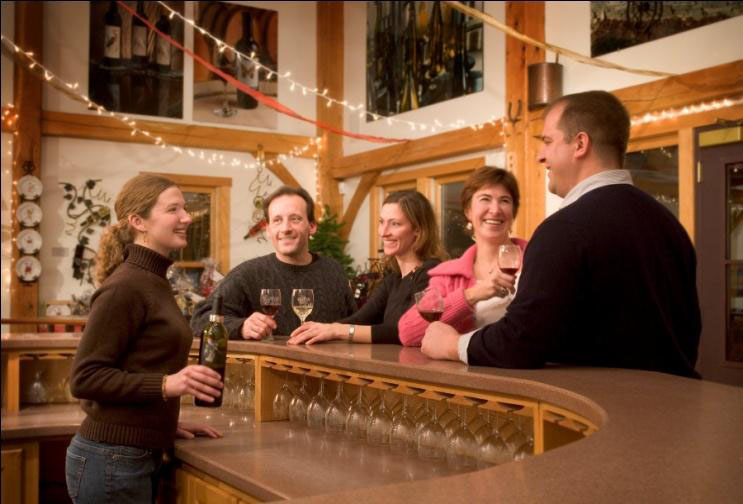
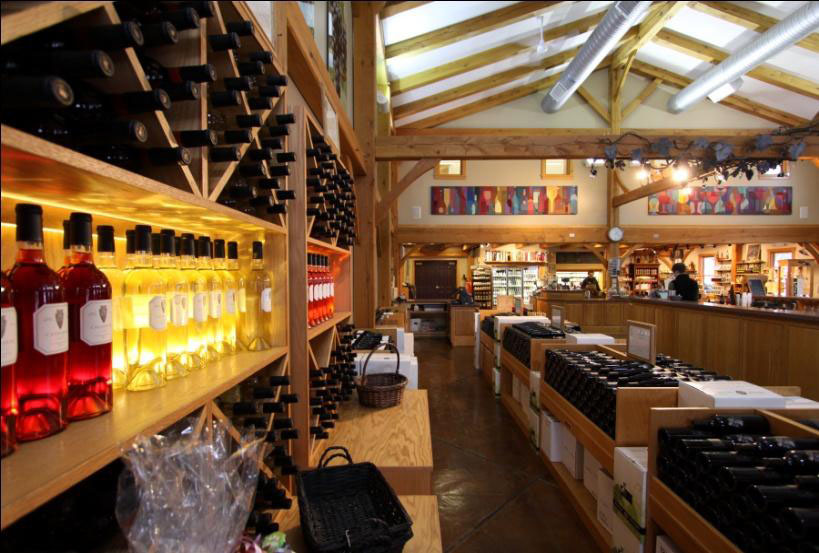
Once hired, new staff members are supplied with a packet of written materials detailing the company's historical development, unique wine-making techniques, and basic information about each varietal. After memorizing this information, new hires are trained to interact with customers, both at the tasting bar and during winery tours, which every Oliver employee conducts on a routine basis. Regardless of job description, every new staff member learns about stocking, shipping, cleaning and bar-backing activities (assisting more senior employees at the tasting bar by replacing bar towels, labeling bottles, and replenishing crackers, water and glasses).
Within each component of the training program, minute attention to detail in delivering exceptional customer service is stressed. Such service includes not only greeting customers promptly and cheerfully as they walk through the doors of the tasting room, but also paying attention to all opportunities to mitigate what authors Kim and Mauborgne (2005, p. 69) call "pain points" in the customer experience: those instances in which the company's offering is not delivered optimally. Trainees are carefully instructed in how to maintain the company's standard of "warm Midwestern hospitality" during busy summer weekends when the tasting bar, outdoor veranda and surrounding picnicking grounds are crowded and the phones are ringing constantly. The lessons include problem-solving and multi-tasking techniques within such a potentially overwhelming environment, as well as service methods designed to impress and delight customers. Most importantly, the training process emphasizes continual reinforcement that each staff member is fully authorized to do whatever is necessary to ensure customer satisfaction and loyalty (including giving away bottles of wine or other products in instances of even slight customer distress).
In addition to the people segment of training, the product and place portions are similarly rigorous. New staff members are immediately indoctrinated into the Oliver aesthetic of spotless cleanliness, artistic beauty and fine craftsmanship. For example, if tasting-room wine glasses have faint dishwasher spots, re-wash them by hand, trainees are taught. If a bottle's label is even slightly off-center, put it aside and open a new one for customer tastings. Place all bottles in storage bins with the labels facing up and centered. Rotate stock continuously so the perfectly aged bottles are sold first. Arrange cheeses, breads and chocolates artfully in the retail spaces. Wrap customer purchases neatly and offer to help carry large orders to waiting vehicles. Pick up refuse in the parking lot and on the grounds, and be sure to pull weeks from the flower beds. While the tasks are numerous, the overriding theme reinforced throughout the training program is simple: maintaining the aesthetic details is just as critical to successful job performance as completing functional, position-specific tasks.
The culminating event of training for new hires - their "graduation" - involves a "soft opening." This is a staged event during which the Olivers invite loyal customers to visit the tasting room during hours when the winery is usually closed to the public. At this time, all of the knowledge and skills that new staff members have acquired are demonstrated and critiqued in a simulated, yet realistic, environment. An understanding of varietal descriptions, food pairings, historical dates, Oliver story themes and methods of superior customer service must all be evidenced before employees are added to the ranks of those scheduled to staff the tasting bar during regular business hours. With the completion of training, new hires have a clear understanding of company standards regarding expected job performance and are equipped to demonstrate those values to the visiting public.
Optimizing
To support ongoing staff development, the Oliver management team devotes significant time to working alongside new and tenured employees in the front lines of daily operations. These company leaders often slip behind the tasting bar and help pour tasting samples, interact with customers, stock glasses, accompany guided tours, assist with processing and packing and help with grape picking during harvest time. In this way, the winery's leaders provide mentoring and coaching while creating an ongoing stream of development opportunities for staff members.
To further bolster the ability of their staff to provide superior wine-tasting experiences, the Olivers have established a tradition of knowledge-sharing within the company. Across the rest of the U.S. wine industry, the general practice is to separate the makers and sellers of wine. That is, the production staff rarely interacts with the retail sales team. Oliver Winery's vintners, however, recognize the many advantages of highly knowledgeable customer service representatives. The pursuit of frontline expertise has resulted in routine staff-only wine tastings conducted after business hours. During each of these informational sessions, retail, production and leadership employees gather together at the tasting bar to sample both the company's wines and those of its competitors.
During these events, Oliver's vintners explain the processes involved in crafting each wine, and staff members are encouraged to identify the flavors they taste and to share descriptions that can be used to educate their customers. Imaginative wine and food pairings are debated as well as more specific ideas including which occasion or season could best complement each wine. Through these meetings, employees become more skilled at articulating both varietal-specific characteristics, as well as differentiating elements of Oliver Winery's products. The end result is a an highly educated staff, equipped with a much higher "wine IQ" and a greater ability to provide meaningful winery experiences for the business's customers.
Throughout the optimization process, the Olivers create an environment wherein employees are expected to engage in the process of continual improvement. Staff members from all levels of the organization join together in an iterative process of developing, testing and evaluating new ideas that enhance their customers' winery experiences. The result is a deep pool of talent from which to draw for open leadership positions. It is not surprising, therefore, that the majority of Oliver Winery's leadership team members have been promoted from within after starting in entry-level positions.
The Role of Storytelling in Sharing Culture
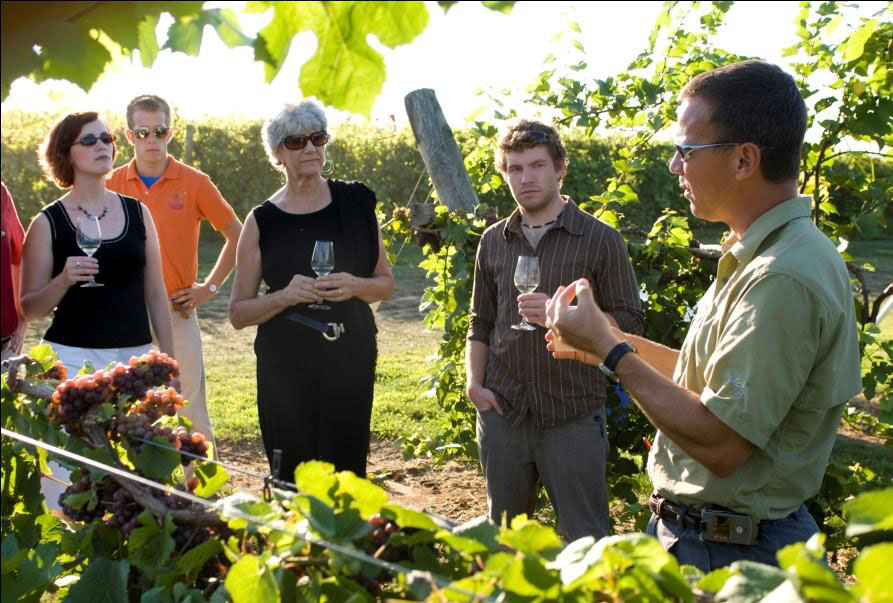
The Olivers further align the experiences of both employees and customers with their personal values by infusing several company legends into daily operations. These stories center around three distinct themes: (1) the roots of the company's historical success; (2) the mystery of the winery's Creekbend Vineyard; and (3) the Olivers' vision for the future of their company. Every day, employees relate these tales of improbable success,craftsmanship and optimism to each customer at the wine-tasting bar and during guided tours.
Every half-hour each Friday, Saturday, and Sunday, visitors are able to take part in a tour of Oliver Winery's production facilities. The tours begin by entering the legendary cellar that was constructed by Professor William Oliver and his law school students nearly four decades earlier. After discussions about the winery's origins, the tour groups walk through the more modern production facilities, pausing at points of particular interest in order for the guide to offer historical framing, explanation of current operations and plans for future initiatives.
Story Theme #1: Stories of the Roots of Historical Success
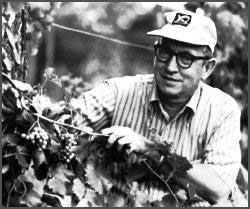
Professor William OliverIn 1973, Professor Oliver began creating Camelot Mead, the honey-based wine by which Oliver Winery earned its initial recognition. More than just a wine, Oliver's Camelot Mead represented the company's commitment to quality over convention - the convention being that wine was traditionally crafted from grapes. At the time, Indiana vintners had not yet learned how to coax consistently superior grapes from a sub-optimal climate, and rather than produce marginal grape wine vintages, Professor Oliver chose to focus on a wine product with a more consistent quality.
Traditionally consumed by the masses, Camelot Mead is highly accessible to a broad array of wine appreciators. Additionally, the product holds nostalgic value among long-time Oliver wine consumers, who have supported the company since its founding and are able to remember how this wine was first crafted in the basement of Professor Oliver's home. Historically, mead was served to celebrate the joys of living, and the strong resonance with this tradition has lent significant marketing value to the product.
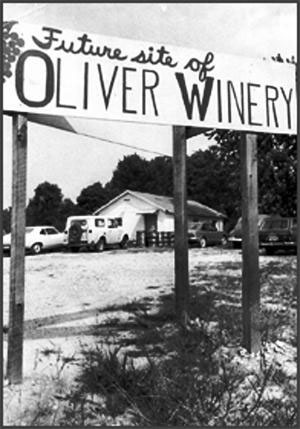
Arguably the most notorious aspect of Professor Oliver's career as a vintner was his effect on Indiana's winery laws. As an Indiana University law school professor, Oliver maintained a unique connection with his students, many of whom worked in his vineyard on the days of his course lectures. While their professor lectured course material, students pruned vines, harvested grapes and constructed the winery's first public tasting room. Some of these students became state legislators and when Professor Oliver submitted the Indiana Small Winery bill (now Act), they undoubtedly helped with its enactment. The Indiana Small Winery Act enabled Indiana wineries to produce yearly quantities of up to 100,000 gallons, pursue the retail and wholesale distribution of product and sell wine on Sundays in public tasting rooms. With the passage of this legislation, vineyards became the only exception to the Indiana law prohibiting the sale of alcohol on Sunday; a unique situation that currently is upheld in many counties which still prohibit other vendors of alcohol from selling their products on that day.
Story Theme #2: Stories of the Mystery of Creekbend Vineyard
Oliver's Creekbend Vineyard was launched in 1994 by planting three acres of grapes that do not normally grow well in Indiana - Cabernet Sauvignon, Cabernet Franc, Merlot, and a hybrid called Chardonel. Creekbend has proven so successful that it now encompasses 37 acres and more varieties of grapes are regularly added. The vineyard is geographically distant from the public tasting-room, and while the tasting room, production facilities, surrounding grounds, and verandas are all open to visitors on a daily basis, Creekbend is held in constant tension with that accessibility due to its relative exclusivity.
Due to the experimental nature of the vineyard, and the fact that the results of efforts there are dependent on the unique and changeable climate of Indiana, every season's production is unique. A 2006 Creekbend Cabernet Sauvignon, for example, tastes very different from a 2007 vintage. Because of these challenges, the legend of Creekbend grows more potent with each successful harvest. Of particular note is the production team's achievement in growing grapes used for award-winning ice wine. These grapes are picked after the season's first hard freeze which acts to concentrate the juices, producing an exceptionally sweet dessert varietal. Capitalizing on the Indiana growing season - which is long enough to fully ripen the grapes, but cold enough to freeze them before they rot on the vine - Oliver produced exceptional ice wine that was awarded "Best of Show" at the 2005 Mid-American Wine Competition.
Story Theme #3: Story of the Vision for the Future
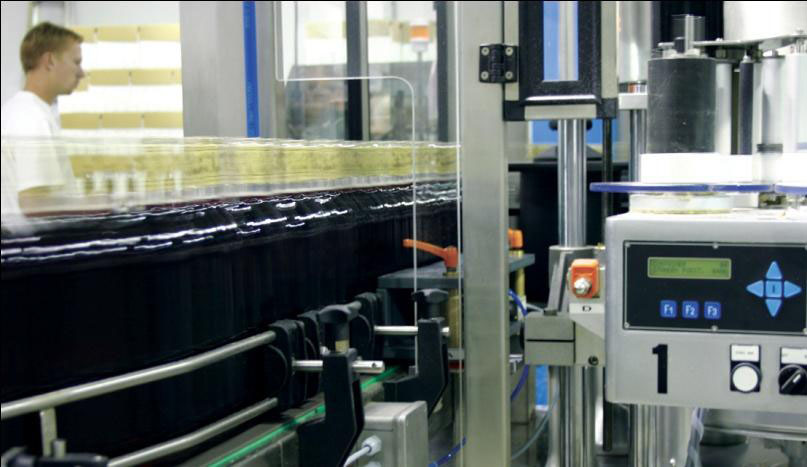
Since the early 1990s, Oliver Winery's annual production of wines has increased from 38,000 to over 820,000 gallons. The recent installation of a new production facility added twelve state-of-the-art, stainless steel tanks with automatic temperature controls. These tanks contain features which closely monitor the fermentation process in order to optimize the quality and taste of the wine. A new bottling line capable of filling, corking, and labeling 8,000 bottles per hour was also added. The new line demonstrates great flexibility in terms of bottle shapes, sizes, and labels. As a result of these improvements, Oliver has gained the ability to triple its current annual production with only relatively modest additional capital outlay. This will enable the company to efficiently provide sufficient product for growing wholesale markets in the future.
Product
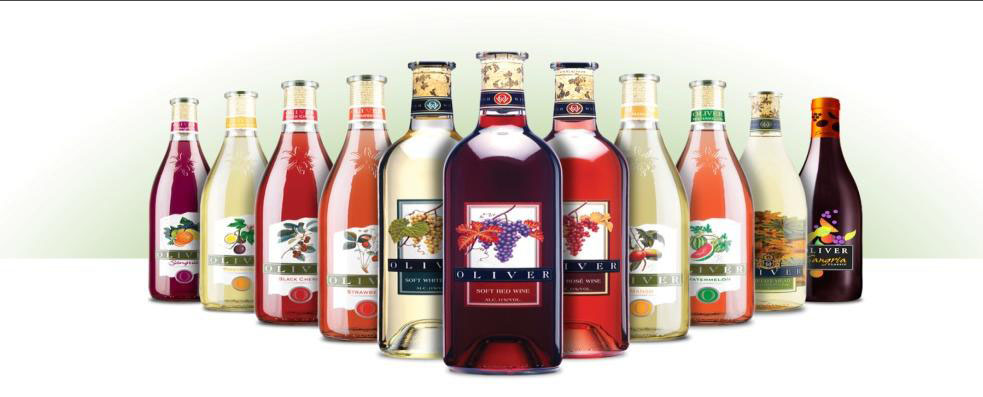
The breadth of Oliver Winery's product line differentiates it from the majority of its peers. While most vineyards typically offer only two or three varietals, Bill Oliver has established a portfolio that boasts a selection of 33 different wines: 11 dry, 10 semi-dry, 9 semi-sweet, and 3 dessert. Of these, 10 are created from grapes grown at Oliver's Creekbend vineyard, while the other 23 are crafted from externally sourced grapes or grape juice (called sepáge). While supporting production from the winery's own Creekbend Vineyard allows the company to cultivate its authenticity as a southern Indiana vineyard, the decision to nationally source a large quantity of grapes acts to ensure materièl of consistently high quality and sufficient supply.
Bill Oliver describes the artistry involved in wine-making as similar to cooking a fine meal. A good chef starts with premium ingredients, either purchased from trusted vendors or produced in one's own garden. Wine-making for Bill Oliver is much the same (Jaqua, 2008). Whether internally or externally sourced, the grapes for Oliver wine undergo a production process that is aligned with the vintner's commitment to "make approachable and satisfying wines that emphasize the varietal character of high quality fruit" (www.oliverwinery.com/winemaking). In other words, as Bill Oliver explains, "Let the grape speak!" (Jaqua, 2008). This respect for the nature of each varietal results in providing customers with wine-tasting experiences based upon clean and uncomplicated homage to the grape varietal.
By eschewing industry tradition and offering a broad range of drinkable wines, Oliver Winery has widened its customer base considerably. Visitors with wildly differing tastes can easily access the wine list by choosing from a selection of wines within each of several different categories. This inclusive portfolio has allowed the company to convert many non-wine drinkers into a thriving population of Oliver wine appreciators. Significantly, the didactic nature of the company's offering (i.e., the instruction given at the wine-tasting bar and during tours of the production facilities) enables the company to tap the large population of Indiana University students and their parents as customers. As each university class reaches legal drinking age, Oliver tasting room employees (many of whom are IU students themselves) stand ready to help them discover the world of wines. With 33 different possibilities, nearly everyone can find at least one varietal that is pleasing.
Visiting the winery also proves to be an excellent outing for parents as they travel to Bloomington to visit their students. In addition to wine, visitors are able to select from a complimentary assortment of fine foods, art and accessories that are arranged within both a small retail corner and subtle displays throughout the tasting room. Each item within the retail spaces is closely aligned with the company's value of providing a finely crafted, warmly hospital and fully accessible winery experience. Even those who don't drink alcoholic beverages are able to find refreshment in juices, natural sodas and myriad food items available for sale. There is something for every visitor to enjoy, and the results of this inclusiveness are clearly visible during busy summer weekends, as large groups of college students, business colleagues, local residents and families with small children all seamlessly mingle both within the tasting room and throughout the outdoor verandas and picnic areas. By providing a welcoming, non-elitist approach to wine appreciation, the Olivers not only add substantive value to their customers' experiences, but they also enjoy augmented revenues from a relatively broad customer base.
Place
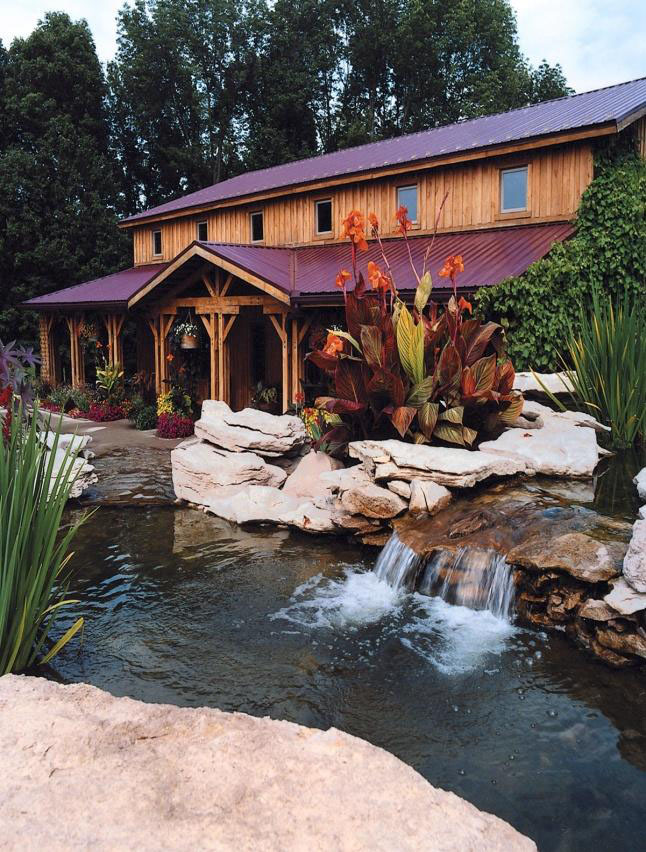
The value that Bill and Kathleen Oliver place on visual aesthetics is apparent throughout the tasting room, production facilities and surrounding twenty-acre grounds, which have become a destination for visitors from around the region. The winery's landscaping is defined by massive geometric limestone slabs that anchor manicured flowerbeds. A broad expanse of meticulously groomed lawn slopes down behind the tasting room, punctuated by hand-hewn benches and picnic tables. Lily pads and ornamental grasses frame a large koi pond, offering an appealing location for picnicking visitors. Along the pathway leading to the winery's main entrance is a limestone waterfall that serenades visitors past the large patio and deck areas, through wide front doors and into the tasting room.
Thick beams of solid oak reminiscent of backcountry lodges crisscross the tasting room's 30-foot vaulted ceiling. An iron grapevine sculpture "grows" from the floor in the center of the granite bar and sends its vines to twist along the beams above. The work of local artists is ubiquitous and can even be found on the wine bottle labels themselves. William Zimmerman, who created the bar's grapevine sculpture, has created a series of labels that feature highly detailed paintings of birds and flowers. These labels earned the winery the "Clear Choice Award" from the Glass Packaging Institute in 2005, as well as first place in offset printing from the "Tag and Label Manufacturers Institute" (for the Pinot Grigio Blue Heron label).
Every detail in the tasting room and throughout the production areas is attended to with meticulous care and craftsmanship, from the custom-made hanging varietal signs to the spotless floor of the grape fermenting room. Visitors to the winery are surrounding by an environment that rivals the aesthetic beauty of the globally-recognized wine regions of France, Spain and the western United States. Every surface and corner of the tasting room is composed of slate, hardwood, ceramic tile, thick glass, or wrought iron. Every pallet and box of materiél is stacked neatly and labeled professionally throughout the production areas. Each flower bed is artistically designed and meticulously attended. The Olivers and their staff have not missed a single opportunity to communicate their shared value of delivering an optimal wine-tasting environment for their customers.
In addition to paying careful attention to the company's internal environment, the Olivers express their commitment to philanthropically engaging their community with their innate understanding that "It's just the right thing to do" (Oliver, 2009). They have focused their giving entirely on their own community of Bloomington. The variety of organizations to which they donate is quite substantial, including local arts organizations, parks and recreation, the chamber of commerce, band boosters, firefighters and Rotary Clubs. Additionally, Oliver Winery is the main sponsor of Indiana University's Auditorium, where the winery's product is served during special university events for which the company donates not only the wine and food, but also staff services. Due to the latter part of the gift, Oliver is delivering a complete wine appreciation experience, rather than a simple product donation.
Results
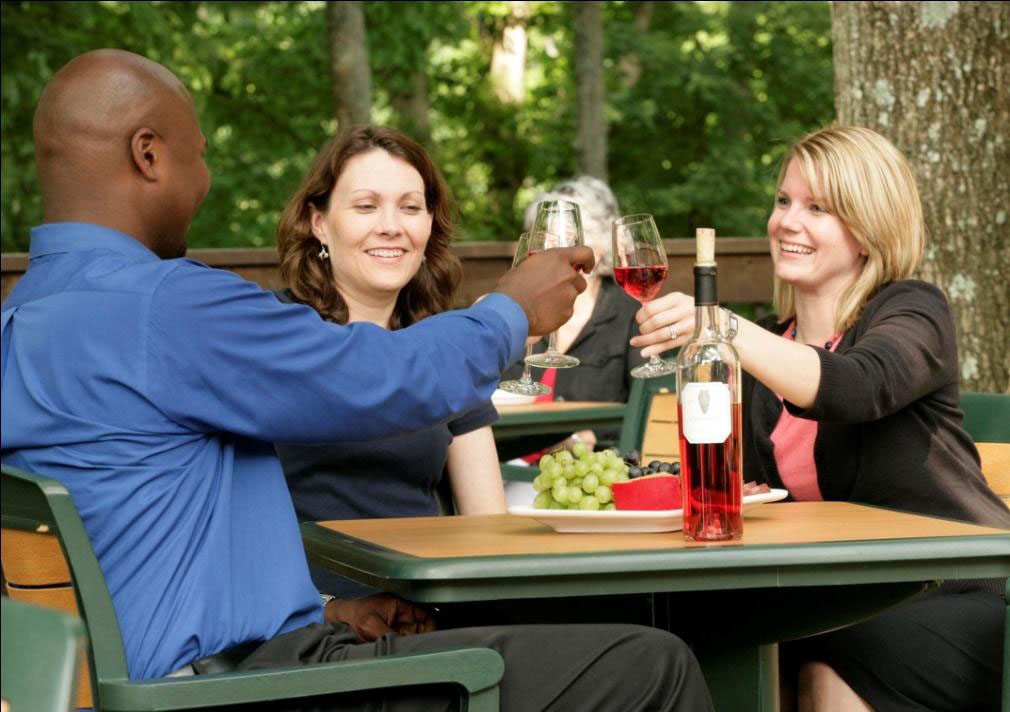
When Bill Oliver first assumed control of winery operations in 1983, 80 percent of all revenue came from retail tasting-room sales, while the remainder originated through wholesale channels. During the past three decades, this ratio has reversed. Since its founding, the company's wholesale success has been built upon the ability of the tasting room to generate demand through wholesale channels.
The exceptional wine experience that visitors have at Oliver creates loyal fans who, upon returning home, supplicate their own grocers, restaurateurs and wine shop owners to begin carrying Oliver wines. Additionally, these customer "promoters" (see e.g., Reichheld, 2006, p. 30) extol the winery's products, beautiful environment, and extraordinary hospitality to their friends and families. A special subset of these "ambassadors" is created by the winery's employment of and engagement with Indiana University students and parents. Upon graduation, these customers spread out across the country, carrying with them their loyalty to IU and Bloomington, as well as to Oliver Winery and its products.
In 2002, Bill and Kathleen hired a wholesale sales manager in order to satisfy requests for their wine from out-of-state wholesale distributors. That same year witnessed the winery's entrance into the Kentucky and Ohio markets, and in the following years the company ventured into Michigan, Illinois, and non-contiguous states, including Florida and Kansas. As mentioned above, sales are growing robustly, illustrating the effectiveness of the Olivers' values-based business model.
Lessons Learned

For the leader striving to create a values-based business, how can he or she ensure that an organization is truly constructed upon core values, rather than simply lacquered with a patina of values-based jargon, hollow mission statements or fleeting, fad-based initiatives? We believe the Oliver Winery story provides valuable lessons that can help in this journey.
#1. The Right Values have Power
Not all values are created equal. While research certainly demonstrates the power of a strong culture of shared values (Brauer, 2009; Cameron, 2008; Kouzes and Posner, 2007), to say that alignment with any set of common beliefs creates sustainable success would be folly. Consider the recent housing and mortgage fiasco that led to the global financial crisis. Many homebuyers, lenders, Wall Street investment bankers and brokers all shared the "value" of short-term profit maximization. This value has proven to be unsustainable and reckless, as well as arguably criminal.
Compare this situation with that of the Olivers, whose business has been built upon a very different set of shared values: those of inclusion, authenticity, deep respect for staff and customers, uncompromising quality, constancy of purpose and long-term focus. These values have provided a foundation upon which three decades of consistent growth in revenues, profits and loyal customers has been realized. The values' power lies in the fact that they are not simply rhetoric; they are deeply internalized by all staff and act as a guide for every decision and action.
#2. Deep Belief and Understanding
A successful business is composed of thousands of right decisions. Moreover, the type of sustainable success experienced by Oliver Winery is made possible by staff members who are passionate about what they do and consequently make choices commensurate with the company's values. This energy-intensive process is not predicated upon mere rhetoric or imagery, but is sourced instead in the more fundamental emotional and intellectual drivers of belief and understanding. If leaders and staff are to consistently address situations that do not reflect company values, they must first have deep belief in and understanding of shared organizational standards, which provide guidance in the decision-making process. Such internalization of company values effectively prevents short-sighted actions based on superficial financial analysis, "conventional" wisdom, or the shortest route to task completion.
#3. Values and Gestalt
Recall Kathleen Oliver's observation: "People, product and place: Each one is integral to our success - if one component fails, then we greatly reduce our positive impact on the customers." This statement reflects the importance the Olivers place on infusing their values into the gestalt, or the inseparable whole, of the company. Let us examine the lessons provided by this commitment to creating organizational alignment:
a) Hire Values, Teach Skills:
In Good to Great (2001), Jim Collins asserts that "People are not your most important asset. The right people are" (p. 51). "The right people," Collins states, "don't need to be tightly managed or fired up; they will be self-motivated by the inner drive to produce the best results and to be part of creating something great" (p. 42). For the Olivers, the right people are those that already hold the same values as the company. Care is taken in the hiring process to assure a "good fit" by placing heavier emphasis on values and character than skill sets or experience. The Olivers find it easier to hire values and teach skills, than to hire the skills and try to change an employee's values. As Katherine Dean argues, "By inviting only those with similar values into the organization, leaders create opportunities for employees to feel deep connections with and respect for the company: links which create the foundation for good decision-making" (Dean, 2008).
b) Develop According to Values:
Research demonstrates that committing higher than average resources to training systems yields a greater return on investment per employee, better customer service and deeper employee commitment to the company's values and vision (see Kouzes and Posner, 2007, p. 91, 171, 261). For Bill and Kathleen Oliver, two of their most effective training mechanisms have been the "soft opening" events and the infusion of values-based company legends into daily operations. The former of these tools enable new staff members to gain confidence in performing at the level expected by management while concomitantly preventing underachieving employees from interacting with customers until they have proven competency. The latter of the tools (storytelling) serves to continuously relate company values to the staff under the guise of educating customers about the product line. By instilling nearly every conversation between employee and customer with some segment of the Oliver story, the company's traditions of excellence, continual improvement and optimism for future success become ubiquitous, and deeply influential to employee decision-making processes long after training is complete (see e.g. Cameron, 2008).
c) Promote from Within:
Bill and Kathleen Oliver have created organizational leaders by "enabling them to see clearly, and to achieve effectively, that which they hold dear" (O'Toole, 2008). Due to rigorous training, the Olivers can be confident of the alignment of what they and their employees hold most dear: achieving the extraordinary. Furthermore, by creating such an integrated management of people, product, and place, the Olivers can rest assured that they are making it very uncomfortable for those who don't share their values to remain working at the winery. There is simply no dark corner within such a tightly woven environment for low-achievers to hide (Collins, 2001, p. 51; Kouzes and Posner, 2007, p. 56).
Those who remain with the organization become more deeply aligned with and supportive of company initiatives, which resonate with their own values about how to achieve excellence. The winery's leadership follows the ideology that "the growth of any organization is simply the accumulated growth of the individual relationships that constitute it" (Reichheld, 2006, p. 188). Such committed relationships are rewarded with invitations to advance within the company. As mentioned previously, the majority of the Olivers' leadership team has been promoted from within the organization. While some business leaders may question this practice, the empirical evidence overwhelmingly endorses it. Returning to Jim Collins's Good to Great, we learn that bringing in a "high-profile outside change agent is negatively correlated with a sustained transformation from [a] good to great [organization]" (p. 31). In a values-based company, promoting from within is not only an acceptable practice, but an advantageous one. Candidates have already been vetted, tested, and strengthened and have proven their character, aptitude, and commitment to the company's principles.
d) Align the Environment with the Values:
The Olivers have invested considerable resources in crafting their company's physical environment. They understand that the retail spaces, production facilities and extensive landscaping send powerful messages about the company's values, which in turn affect morale, performance and loyalty (Cameron, 2003). "Just like verbal symbols," authors Michael G. Pratt and Anat Rafaeli (2001) instruct, "multiple physical symbols can be put together to clarify, bolster or qualify a point." In the case of Oliver Winery, the ubiquitous symbols of fine craftsmanship and generous investment in aesthetic beauty are communicating (and then emphasizing) the value the company's leaders place on experiential stewardship. The Olivers' visible dedication to enhancing the working environment encourages staff to mimic, and customers to enjoy, these efforts.
#4. The Product is More Than Just the Product;
Bill and Kathleen Oliver are not just selling wine - they are providing a complete customer experience that is infused with the company values of excellence, hospitality and attention to detail. In his text Clued In: How to Keep Customers Coming Back Again and Again (2004), author Lewis P. Carbone extols such "purveyors of experience" (p. 25). "In the aftermath of a transaction," Carbone relates, "the way people remember and value an experience emotionally will have everything to do with their ultimate commitment to an organization or brand" (p. 65). Customers are loyal to Oliver Winery not just because they enjoy its wine, but because they attach a premium to the values that are so clearly demonstrated by the company's extraordinary focus on the customer experience.
#5. Values Transcend Organizational Boundaries
The Olivers intimately manifest author Brauer's (2009) general observation that "being a part of - as opposed to simply being geographically located in - a community is necessary to properly link social values with the company's products and services." Through a values-based experiential offering and highly visible philanthropic efforts, the Olivers create deeply relational (as opposed to purely transactional) engagements with their customers. These sustained relationships blur the boundaries between customer and company and company and community, with the effect that the customers themselves transform into an effective sales tool for the winery's product. This reciprocal situation is both functional and satisfying; just as the company needs the support of the local population to flourish, the local community benefits from having the winery as an essential part of the community.
Final Thought
One of the most interesting aspects about Bill and Kathleen's approach to building a values-based business is that they have done so without a written mission statement. This seems to run counter to convention, which holds that a business should start with a clear statement of purpose. Unfortunately, the value of such public proclamations is compromised every time organizational actions are taken that are inconsistent with it. What the Olivers show us is that more attention should be paid to what a company's decision- makers do, rather than what they say they are doing. Their values are imbedded in every decision and in every action - every day. After all, as Ben Franklin has assured us, not only is it imperative to "do well by doing good," it's also true that "well done is better than well said."
References
Albion, Mark (2008). "Turn Your Values into Value." The Journal of Values-Based Leadership 1.1, 48-56.
Brauer, David B. (2009). "The Values-Based Revolution." The Journal of Values-Based Leadership 2.2, 80-98.
Cameron, Kim S.(2003). "Organizational Transformation through Architecture and Design." Journal of Management Inquiry 12, 88-93.
Cameron, Kim S. (2008). "Positively Deviant Organizational Performance and the Role of Leadership Values." The Journal of Values-Based Leadership 1.1, 65-80.
Carbone, Lewis P. (2004). Clued In: How to Keep Customers Coming Back Again and Again. Upper Saddle River, NJ: Prentice Hall Financial Times.
Collins, Jim (2001). Good to Great. New York, NY: HarperCollins Publishers.
Dean, Katherine W. (2008). "Values-Based Leadership: How Our Personal Values Impact the Workplace." The Journal of Values-Based Leadership 1.1, 57-64.
Jaqua, Nicholas (2008). "Reverence for Terroir." Indianapolis Dine, 78-84.
Kim, W. C. and Mauborgne, R. (2005). Blue Ocean Strategy: How to Create Uncontested Market Space and Make the Competition Irrelevant. Boston, MA: Harvard Business School Press.
Kouzes, James M. and Posner, B. (2007). The Leadership Challenge. San Francisco, CA, John Wiley & Sons.
Kouzes, James M. and Posner, B. (2008). "We Lead from the Inside Out." The Journal of Values-Based Leadership 1.1, 33-36.
McMillan, Rob."2009-2010 State of the Wine Industry." Silicon Valley Bank: Wine Division. 1 June 2010 <http://www.svb.com/pdfs/wine/StateoftheWineIndustry0910.pdf>.
Millick, Charles A. (2009). "Values-Based Leadership and Happiness." The Journal of Values-Based Leadership 2.2, 53-63.
Oliver, Kathleen (2009). Personal correspondence. Email to Alexandra Schroeder. Sept.
O'Toole, James (2008). "Notes Toward a Definition of Values-Based Leadership." The Journal of Values-Based Leadership 1.1, 81-88.
Pratt, Michael G. and Rafaeli, A. (2001). "Symbols as a Language of Organizational Relationships." Research in Organizational Behavior 23, 93-132.
Reichheld, Fred (2006). The Ultimate Question: Driving Good Profits and True Growth. Boston, MA: Harvard Business School Press.
Thomas, Robert J. (2008). Crucibles of Leadership: How to Learn from Experience to Become a Great Leader. Boston, MA: Harvard Business Press.
Tozzi, John (31 May 2010). "New Legal Protections for Social Entrepreneurs: Maryland allows companies to put principles before profits; California and Vermont may be next." Focus On Entrepreneurs, <http://www.businessweek.com/smallbiz/content/apr2010/sb20100421_414362.htm>.
"Winemaking." Oliver Winery. 1 June 2010 <http://www.oliverwinery.com/winemaking>.Author Biographies
A research team of three dynamic intellects partnered with Southern Indiana-based Oliver Winery to develop a model for leading values-based businesses to thrive and endure within an increasingly globalized and competitive marketplace. Team leader Allyson Baughman (B.A. in Folklore, Indiana University Bloomington; M.B.A., Valparaiso University) addressed how organizational values are delineated and transmitted among members, with special emphasis on the role of storytelling in the didactic process. Alexandra Schroeder (B.F.A., Bradley University; M.A., Indiana University Bloomington) explored how shared beliefs are communicated and emphasized through environmental aesthetics, with a keen eye towards how artistic beauty enhances organizational performance. Valparaiso University Herbert and Agnes Schulz Professor of Management Dean Schroeder (Ph.D., University of Minnesota) brought his considerable experience and expertise to bear on analyzing the values-infused processes, systems and structures that form the foundation of extraordinary, sustainable performance.
Together, this unexpected team of folklorist, artist, and organizational strategist detailed the mechanics of building and sustaining high-performing, values-based organizations. The lessons learned are at once revolutionary and timeless, simple yet comprehensive. It is the hope of the researchers that the fruits of their cross-disciplinary collaboration may empower all who dare to imagine and build within the new paradigm of the 21st century: Values-Based Leadership.

